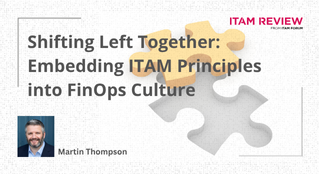The Case For Selecting Smaller Vendors; Nimble, More Value, Better Service?
 This article has been contributed by Christine Headford, CTO at RMS Services.
This article has been contributed by Christine Headford, CTO at RMS Services.
While a few years ago you might have been able to justify buying a new jacket because a button fell off your last purchase, the recession has meant that most of us would now prefer to sew the button back on. And in business, we all resolved to learn the lessons of the credit crunch: don’t spend on over-complicated products, over-long contracts or over-priced services. Not that we intend to scrimp on the essentials – but now, more than ever, organisations need to avoid being taken in by big names and big promises, and focus on buying just what they need.
In IT, however, the big names still seem to rule the roost. Despite observing the lessons of the wider economic situation, those responsible for procuring software and services still seem to believe that a bigger name equals a better service. Buyers often find themselves locked in to one supplier, having been persuaded that it’s best to buy servers from the same place you buy security – even though they wouldn’t dream of buying home insurance and a holiday from the same company.
It is not the buyer’s fault: the IT giants have huge marketing budgets to spend on persuading companies that they are the safe choice. The old adage that ‘you’ll never get sacked for buying IBM’ (or insert any big player) has not gone away, as it has been easy to scare buyers into thinking that a smaller supplier would be more risky, less trustworthy and less likely to be compatible with existing systems.
The IT giants seem to be pulling the wool over business buyers’ eyes in three key areas:
- Expensive equals a superior service
- Bigger equals more innovative
- More complex equals better
Let’s look at these one by one.
Value
In reality, more expensive just means more expensive. Big vendors are answerable to their shareholders, which means their revenue and pricing models are driven by financial results and designed to benefit shareholders, rather than customers. And those big marketing budgets have to come from somewhere – ultimately, sponsorship deals and fancy offices have been paid for by the customer.
Service
With a smaller supplier, companies are actually likely to get better service level agreements, because every customer matters, and represents a bigger proportion of their income. Service will also be more personal, attentive and responsive – which is what most people consider a ‘superior service’.
As well as service, big, expensive software operations would like you to think that the extra money you’re paying is going into increased research and development, resulting in a more innovative product. In fact, in large organisations innovation is often stifled: it can be easier to promote ‘tried and tested’ solutions internally and externally, and levels of bureaucracy can stop the best ideas getting through.
It is unlikely that a supplier’s vast product range has come from years of dedicated R&D: often, big vendors will buy companies to fill holes in the current tool sets, so they can offer everything to everyone. But when it comes to actually using the various systems and software, customers often find that not only are the various elements not intuitively interactive, but that they are faced with using multiple interfaces to access each part. Technology modules from the same vendor don’t always complement each other. People can find that instead of buying into an ‘end-to-end’ approach, they have received some old-fashioned building blocks covered in a lot of sticking plasters.
Bigger Does Not Mean Better
This leads on to the final point, the false promise that more complex products are somehow better. It’s important to remember that areas such as service management are actually a fairly simple requirement for most companies. Getting it right is not rocket science and doesn’t always require the “strategic” approach big vendors offer. Unnecessary over-complication simply adds to the price tag. Indeed, with Information Technology Infrastructure Library (ITIL) in place to form a framework to help implementation, most organisations don’t then need a big strategic plan as well. Smaller vendors use ITIL very successfully, and while every customer will always need individual attention, customers often come to vendors with similar problems, which require a simple, standard approach.
Choosing a small, flexible player over a cumbersome, expensive mega-vendor may not be the right choice for everyone. But as the UK faces some tough choices on where to cut budgets at a personal, professional and country-wide level, 2010 should be the year to re-examine your options, and choose the provider that genuinely offers the most cost-effective option. The right button is a lot less expensive than the wrong jacket.
This article has been contributed by Christine Headford, CTO at RMS Services.
Can’t find what you’re looking for?
More from ITAM News & Analysis
-
Broadcom vs Siemens AG - A Brewing Storm
The ongoing legal battle between VMware (under Broadcom ownership) and Siemens is yet another example of why ITAM goes far beyond license compliance and SAM. What might, at first glance, appear to be a licensing dispute, ... -
Shifting Left Together: Embedding ITAM into FinOps Culture
During one of the keynotes at the FinOps X conference in San Diego, JR Storment, Executive Director of the FinOps Foundation, interviewed a senior executive from Salesforce. They discussed the idea of combining the roles of ... -
Addressing the SaaS Data Gap in FinOps FOCUS 2.1
I recently reported on the FinOps Foundation’s inclusion of SaaS and Datacenter in its expanded Cloud+ scope. At that time, I highlighted concerns about getting the myriad SaaS companies to supply FOCUS-compliant billing data. A couple ...
Podcast
ITAM training
Similar Posts
-
Broadcom vs Siemens AG - A Brewing Storm
The ongoing legal battle between VMware (under Broadcom ownership) and Siemens is yet another example of why ITAM goes far beyond license compliance and SAM. What might, at first glance, appear to be a licensing dispute, ... -
Shifting Left Together: Embedding ITAM into FinOps Culture
During one of the keynotes at the FinOps X conference in San Diego, JR Storment, Executive Director of the FinOps Foundation, interviewed a senior executive from Salesforce. They discussed the idea of combining the roles of ... -
Addressing the SaaS Data Gap in FinOps FOCUS 2.1
I recently reported on the FinOps Foundation’s inclusion of SaaS and Datacenter in its expanded Cloud+ scope. At that time, I highlighted concerns about getting the myriad SaaS companies to supply FOCUS-compliant billing data. A couple ... -
The Future of ITAM
As an ITAM Industry Analyst, I’m often asked what ITAM’s future looks like. This can be a tough question to answer because when it comes to the future, there are endless possibilities. Often, it seems, some ...





